How Propaganda Works. Summary From OPORA
In a world of people with common sense, the key to any legitimate referendum are counting commissions and independent observers. Instead, propagandists were given a leading role in russian pseudo-referendums in four regions of Ukraine. Whereas Ukraine often treats russian propaganda disrespectfully and rejects any possibility to take it seriously, in other countries it sometimes achieves its goal.
For example, we can mention recent materials in Reuters or Associated Press, where news agencies reported on the "results of the referendums" without indicating that they were illegal and illegitimate. However, the occupiers need not only external recognition of their performance but also legitimization of the pseudo-referendum among the local population.
In this coverage, OPORA explored how Telegram became a tool for russians to justify the annexation of Ukrainian territories.
How russia Promoted Illegal Referendums
During regular monitoring of social networks, OPORA identified 127 pro-russian Telegram channels created after February, 20, 2022, that presented themselves as local channels of territories temporarily occupied by russia or those that it had the ambition to occupy (наприклад, Сумы UA, Одесса Za Россию! or ИрпеньUA). Most of those channels are still active and position themselves as news channels for TOTs or channels of the so-called authorities or law enforcement agencies (for example, Администрация города Мелитополя [lit. – Administration of Melitopol City] or ВГА Скадовска [lit. – Military City Administration of Skadovsk]).
In total, over the period from March to September, 2022, those channels published more than 1,600 reports on the preparation, conduct, and campaigning for pseudo-referendums. Among the pages we found, 118 channels engaged in the propaganda activities. The earliest posts with references to the pseudo-referendum date back to March, 3. There, propagandists only mention some hints that they would "think" about the idea.
In terms of content, the vast majority of publications are posts with verbatim quotations of the speakers of the russian regime or the occupation authorities. For all posts, the share of original content, rather than reprints of quotes, is about 30%.
To imitate the electoral campaigning process before the so-called expression of will, the occupiers use the familiar narratives we know very well. For example, to legitimize the pseudo-referendums, the following justifications have been used:
- the "successful" case of annexation of Crimea — russians tell how life on the peninsula changed after the so-called liberation from Ukraine. "Crimean scenario" is presented as a successful precedent, urging Ukrainians in the newly occupied territories to take the tried and tested path of "self-determination" the Crimean residents benefited from. This story is presented as an image of a new and "better" life that will soon be available to the hostages of the occupation authorities. The propaganda convinces of the clarity and certainty of this process from the perspective of previous experience. For instance, they refer to the occupying authorities in the Crimea using legal framework for conducting a pseudo-referendum, and for the organization of the process itself, etc.
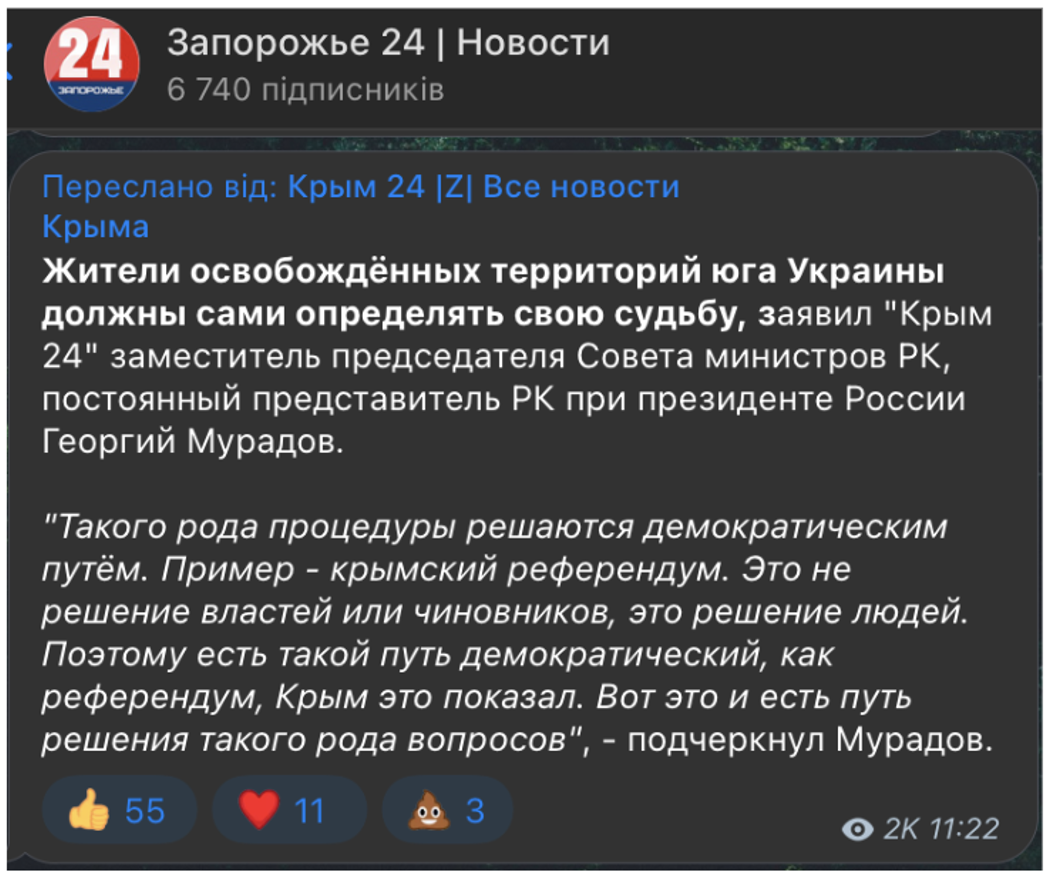
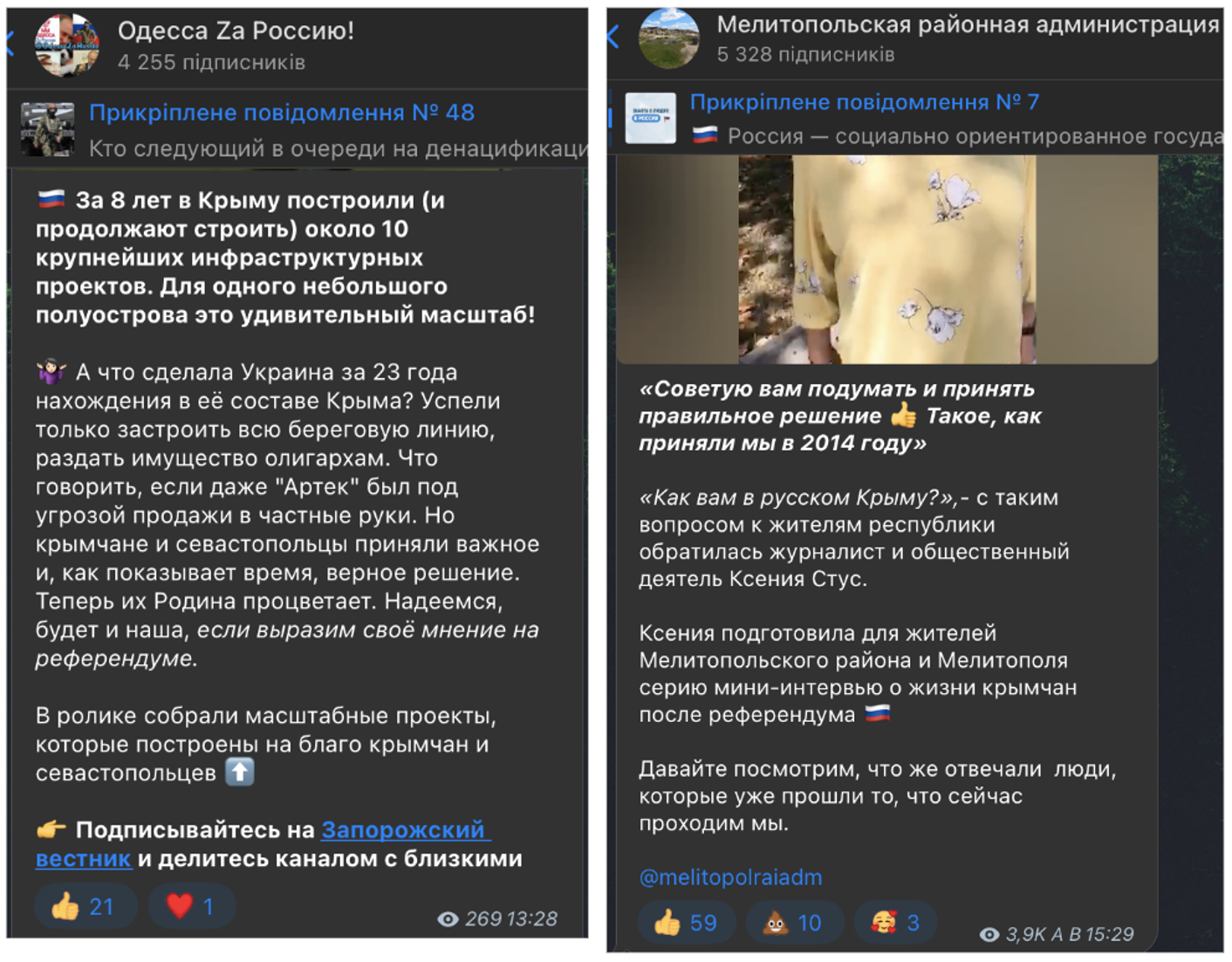
- informing about the structure of medical, administrative, educational, and other systems of the russian federation. This narrative creates an illusion of "informed choice" by residents of the occupied territories of the russian system of social services. The occupiers supplement the propaganda materials with details about how people's lives will change after the establishment of this system (of course, they would change "for the better"). At the same time, such seemingly "educational" posts are often accompanied by calls to make that choice for the future by taking part in a pseudo-referendum.
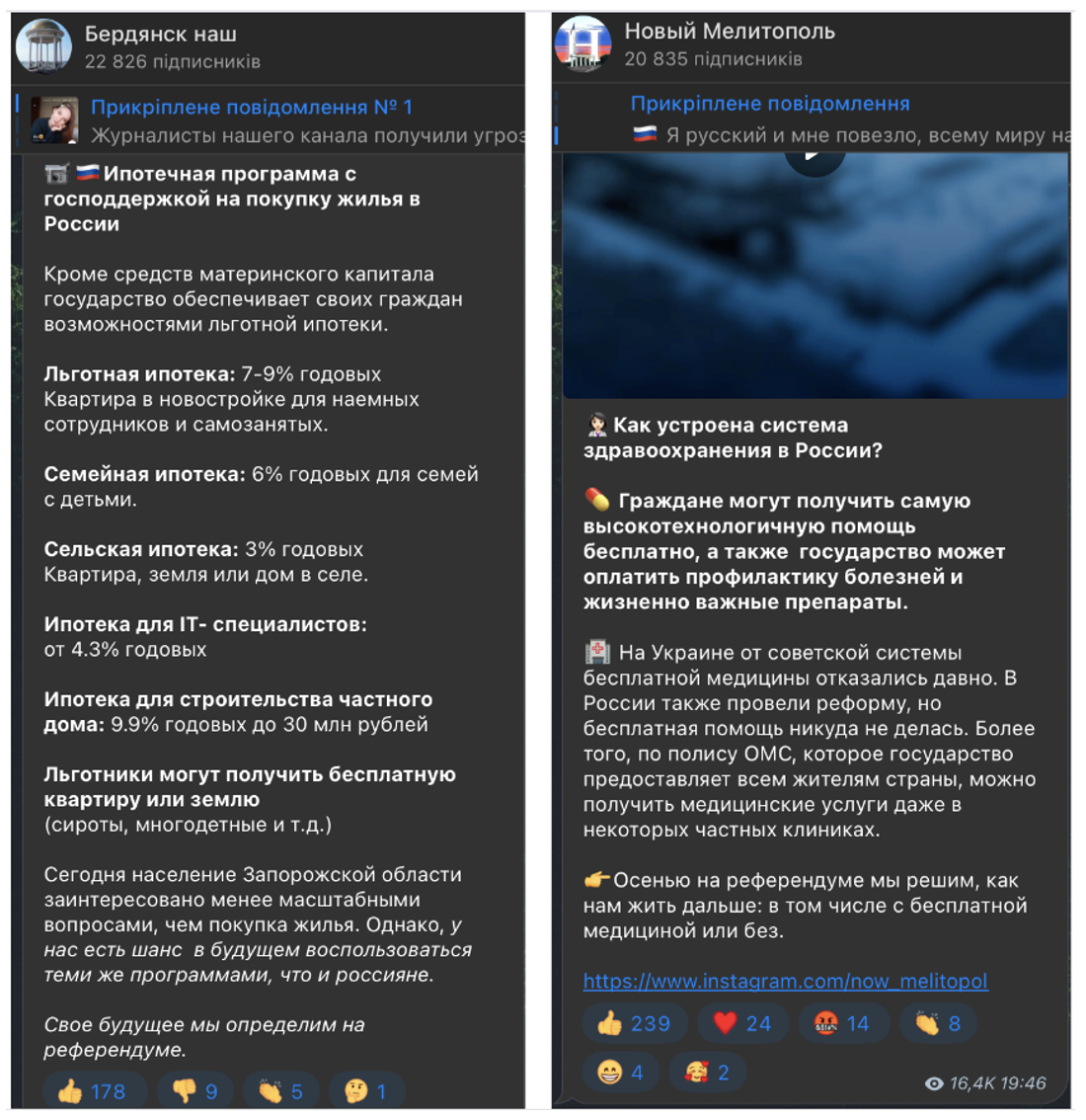
- parallels with referendums on self-determination of other peoples — for example, Scottish narratives on withdrawal from the United Kingdom, references to a pseudo-referendum for the accession of the self-proclaimed "republic" of South Ossetia to the russian federation. The propaganda even refers to Ukraine that also gained its independence following the referendum (but at the same time, in some reports, the occupiers deny the legitimacy of that decision). Thus, the rhetoric of propagandists simplifies the instrument of participatory democracy that requires conformity with the standards of equality, transparency and legality. They reduce it down to the formal act of voting by residents of a certain territory on a certain issue. They ignore the grounds and requirements for the legitimacy and legality of any plebiscite decision.
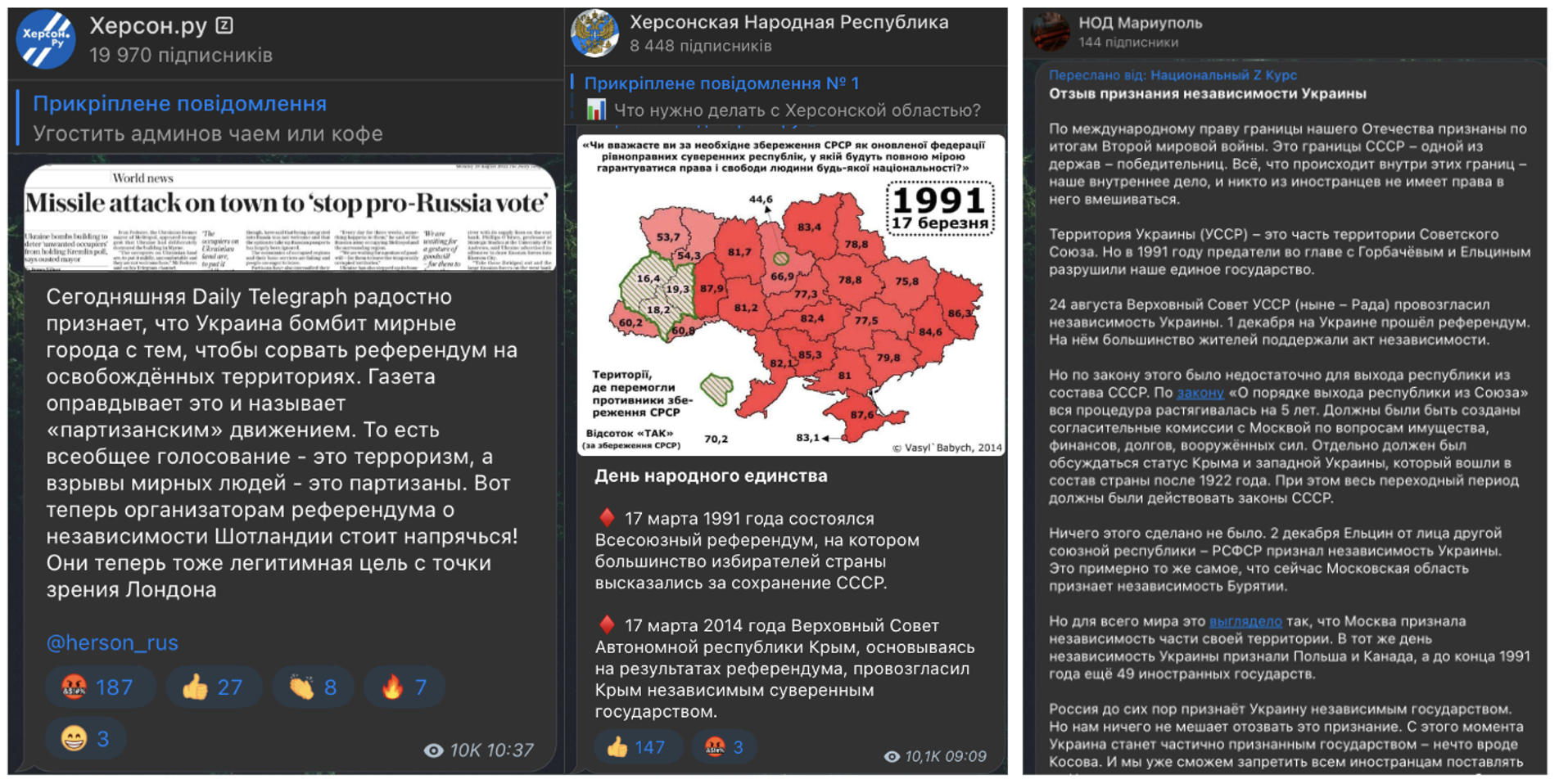
- stories about the simulated process of preparation for referendums (over the monitoring period).
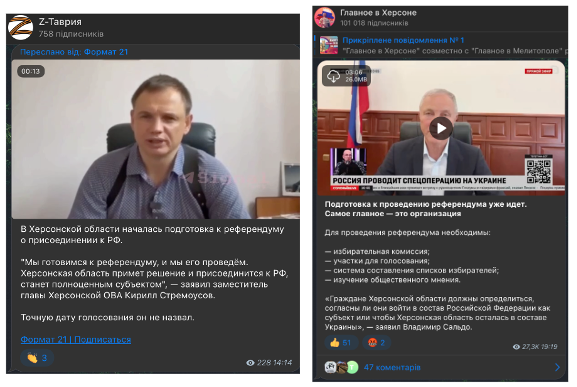
- examples and quotations that boldly confirm the almost unanimous desire of the residents of the TOTs to join russia. In addition to the typical quotes of a seemingly typical TOT resident showing impatience and "sincere desire" to join russia, the occupiers try to add the data to the the illusion of the usual campaigning process: they cite the results of "survey" undertaken by the Crimean Republican Institute of Political and Sociological Studies and Makarenko State University in Melitopol.
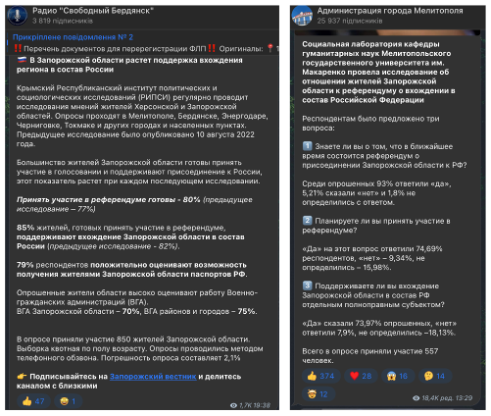
It is also worth paying attention to how russians adapt the misinformation narrative accusing the Armed Forces of Ukraine of shelling civilians living in the temporarily occupied territories. According to propagandists, any shelling of the temporarily occupied territories is an act of intimidation of residents coming from Ukraine and forcing them to refuse to participate in the so-called referendums.
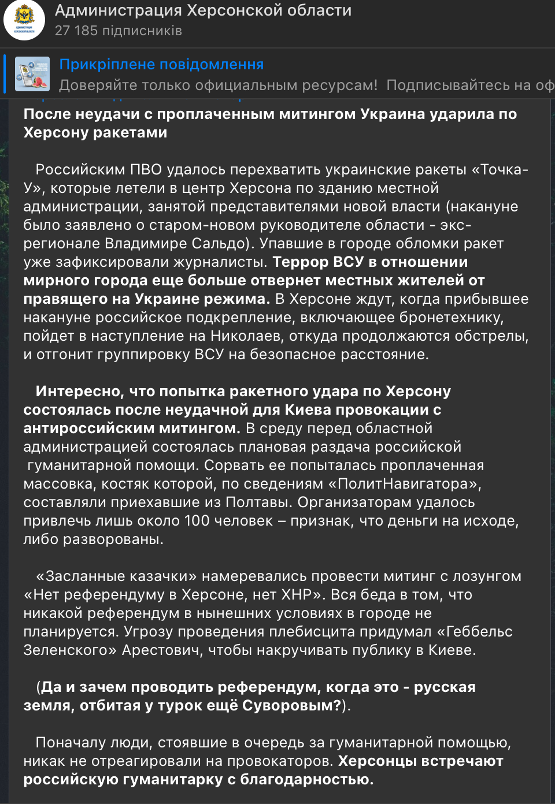
Spider Web of Propaganda-Focused Telegram Channels
It is no secret that one of the most effective ways of propaganda in social networks is to create centralized networks of pages, groups, personal accounts, etc. They work to promote certain ideas or messages. Most popular social media like Facebook, Instagram, or Twitter have had their own policies and tools for tracking and removing such networks for quite some time.
Thus, at the end of September, Meta removed a number of pages from Facebook and Instagram that pretended to be professional news organizations (Bild, The Guardian, etc.) and spread russian propaganda.
Instead, Telegram, the most popular messenger and the main source of news in Ukraine, has neither any clear policy against coordinated behavior, nor any convenient interface for tracking it, nor any opportunity to complain about it. As for the pseudo-referendums in the TOTs of Ukraine, this gap in Telegram policy played in favor of the occupying state.
Among all the reports with references to pseudo-refendums from our database of channels, we found 73 identical posts published by at least five channels from the list. In addition, we found at least two coordinated Telegram channels that actively promoted russian propaganda and encouraged participation in illegal referendums.
The first network we found consisted of 40 channels and focused on cities and towns, mainly in the northern and eastern regions of Ukraine. Thus, eight channels of the network are dedicated to Kharkiv Oblast, six — to Luhansk Oblast and Chernihiv Oblast, five — to Kyiv Oblast, four — to Dnipropetrovsk Oblast and Sumy Oblast, three — to Mykolaiv Oblast and Donetsk Oblast, and one — to Zhytomyr Oblast.
In addition to visual resemblances (the channels have the same style of names and use the russian flag for a channel avatar), all of them were created at about the same time: five channels were created on March, 5, 2022; 11 channels — on March, 6, 2022, 24 channels — on March, 7, 2022. The cumulative number of posts on channels is 30,377; and almost 60,000 users receive information from them.
Among the 30,000 publications of these channels, only about 160 are devoted directly to referendums. However, our attention was drawn to the fact that most of the posts (132) were published by only 12 channels out of 40. Each of these 12 channels published 11 identical referendum posts.
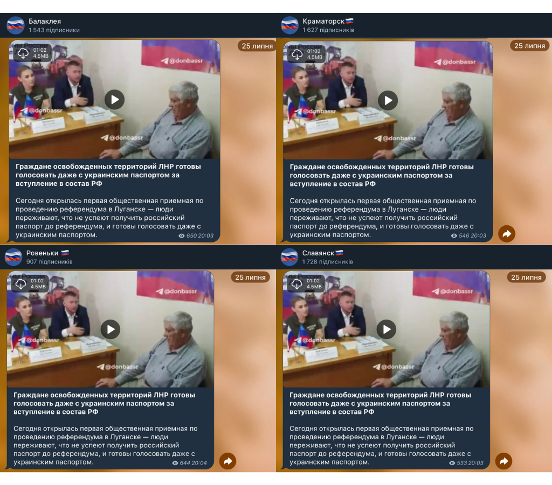
It is indicative that the posts on the channels appeared almost instantaneously at the same time: the average difference between the first and the last of the same posts on different channels averaged only 32 seconds. The record breaking post published by all 40 channels of the network at the same time came on May, 7, 2022 at 14:18:11.
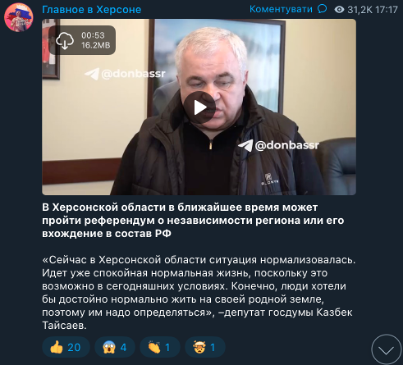
The second network we found includes 10 channels, which, in contrast to the previous one, are focusing exclusively in the southern regions of Ukraine: six pages were dedicated to Zaporizhzhya, and four channels were about Kherson region.
They are visually similar to each other and have identical names. However, they were created throughout a slightly longer period of time: six channels came about in March, three channels appeared in April, and one channel was created in May 2022. The total number of subscribers of these channels is almost 184,000. In total, over 23,000 posts have been published on the channels; Of them, 410 are devoted to the pseudo-referendum.
Unlike the previous network, this one turned out to be quite centralized. The first post usually appeared on thechannel Главное в Мелитополе [lit. – Key updates about Melitopol], and it took several seconds or minutes to have the post shared on other pages.
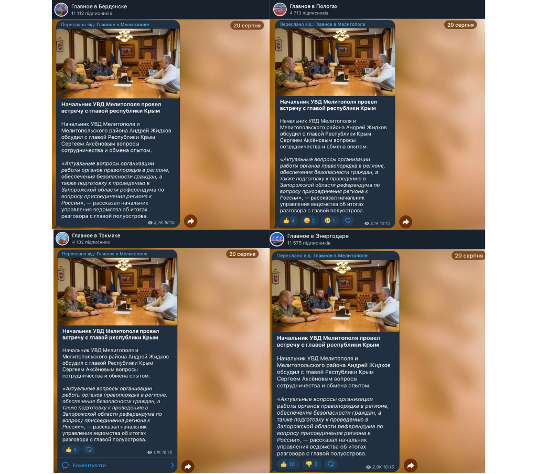
In addition to the identified networks, we also noticed another previously mentioned sign of coordinated behavior in Telegram: some posts appear on many channels of the occupiers at the same time. This is only possible when the same user has access to multiple channels and forwards messages to multiple channels at the same time. For example, this post simultaneously appeared on 29 channels — even on those that were not included in the same network by visual (similar names or avatars) and other indicators:
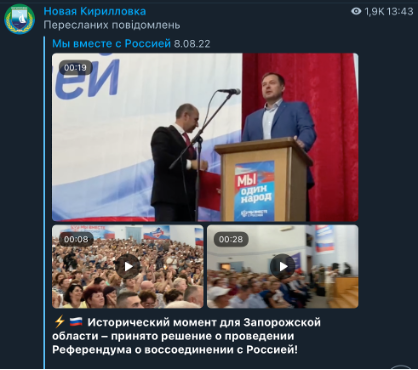
In general, the features of the channels described above indicate that they all have signs of coordinated non-authentic behavior. Given their content and the narratives they promote, we can say that those networks of channels are centrally administered by the intelligence services of the russian federation. The purpose of these actions is to create an illusion among the local population and among russia’s residents that the residents of the temporarily occupied territories really want to live in the russian federation.
What Do We Do, Then?
By exploiting democratic institutions for the act of state terrorism, russia uses all available information channels to perfect its performance. In contrast to the previous period, when the activity of russian social networks and media in Ukraine was not limited and russia had direct access to the Ukrainian information space, now the aggressor uses the "grey areas" of online space to strengthen its propaganda machine.
Thus, over the past few years of the russian-Ukrainian war, almost every report of the Meta company (owner of social networks Facebook and Instagram) has shown notifications of the blocking of coordinated networks of influence administered from russia and targeting Ukrainian audiences. Moreover, the SBU has repeatedly proved the fact that the aggressor used Telegram to destabilize the situation in Ukraine.
Even before the escalation of the Russian-Ukrainian war in February 2022, according to the statements of the Ministry of Internal Affairs, Telegram was the only platform that refused to cooperate with Ukrainian law enforcement officers. The new phase of the war beginning in February, 2022 highlighted the importance of social networks as a tool for information warfare, intelligence, and agent network expansion in the hands of the russians.
By capturing Ukrainian cities and towns the occupiers create a physical and also an information blockade for local residents. Analyzing the case of campaigning for pseudo-referendums in the temporarily occupied territories, we can see how russians are trying to intimidate, confuse, and create the illusion of "a prosperous and happy future in the russian family." Unfortunately, while Western countries block russian propaganda media, and other social networks delete content with misinformation about the russian-Ukrainian war, Telegram shows no enthusiasm for cooperation with the Ukrainian state to protect the information security of a country in war.
The only thing Telegram was willing to offer was a rather maximalist decision to block all channels in Ukraine and russia that cover the russian-Ukrainian war in some way.
As to the possible tools for influencing the moderation policy of the messenger, we can consider only the requirements of the App Store and GooglePlay app stores. They can block access to download the app any time, for violating their policies, and because of the sanctions imposed on the owners of products with their apps presented on the platform (as it, happened to VKontakte).
However, there have been successful practices of recognizing the legislation of countries on which territory the app had an impact. Thus, Germany has achieved cooperation of the company with German law enforcement officers. Therefore, although in the Ukrainian context, Telegram remains an uncontrolled field, Ukraine still has examples of positive practices in establishing such cooperation.
для Zn.ua

